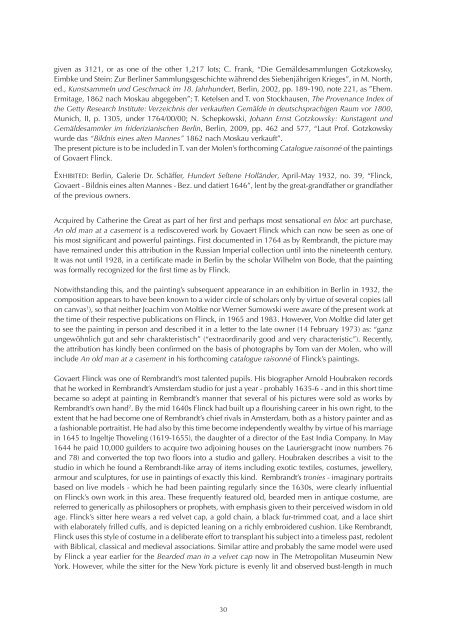Catalogue-2014-Jean-Luc-Baroni
- No tags were found...
Create successful ePaper yourself
Turn your PDF publications into a flip-book with our unique Google optimized e-Paper software.
given as 3121, or as one of the other 1,217 lots; C. Frank, “Die Gemäldesammlungen Gotzkowsky,<br />
Eimbke und Stein: Zur Berliner Sammlungsgeschichte während des Siebenjährigen Krieges”, in M. North,<br />
ed., Kunstsammeln und Geschmack im 18. Jahrhundert, Berlin, 2002, pp. 189-190, note 221, as ”Ehem.<br />
Ermitage, 1862 nach Moskau abgegeben”; T. Ketelsen and T. von Stockhausen, The Provenance Index of<br />
the Getty Research Institute: Verzeichnis der verkauften Gemälde in deutschsprachigen Raum vor 1800,<br />
Munich, II, p. 1305, under 1764/00/00; N. Schepkowski, Johann Ernst Gotzkowsky: Kunstagent und<br />
Gemäldesammler im friderizianischen Berlin, Berlin, 2009, pp. 462 and 577, “Laut Prof. Gotzkowsky<br />
wurde das “Bildnis eines alten Mannes” 1862 nach Moskau verkauft”.<br />
The present picture is to be included in T. van der Molen’s forthcoming <strong>Catalogue</strong> raisonné of the paintings<br />
of Govaert Flinck.<br />
Exhibited: Berlin, Galerie Dr. Schäffer, Hundert Seltene Holländer, April-May 1932, no. 39, “Flinck,<br />
Govaert - Bildnis eines alten Mannes - Bez. und datiert 1646”, lent by the great-grandfather or grandfather<br />
of the previous owners.<br />
Acquired by Catherine the Great as part of her first and perhaps most sensational en bloc art purchase,<br />
An old man at a casement is a rediscovered work by Govaert Flinck which can now be seen as one of<br />
his most significant and powerful paintings. First documented in 1764 as by Rembrandt, the picture may<br />
have remained under this attribution in the Russian Imperial collection until into the nineteenth century.<br />
It was not until 1928, in a certificate made in Berlin by the scholar Wilhelm von Bode, that the painting<br />
was formally recognized for the first time as by Flinck.<br />
Notwithstanding this, and the painting’s subsequent appearance in an exhibition in Berlin in 1932, the<br />
composition appears to have been known to a wider circle of scholars only by virtue of several copies (all<br />
on canvas 1 ), so that neither Joachim von Moltke nor Werner Sumowski were aware of the present work at<br />
the time of their respective publications on Flinck, in 1965 and 1983. However, Von Moltke did later get<br />
to see the painting in person and described it in a letter to the late owner (14 February 1973) as: “ganz<br />
ungewöhnlich gut and sehr charakteristisch” (“extraordinarily good and very characteristic”). Recently,<br />
the attribution has kindly been confirmed on the basis of photographs by Tom van der Molen, who will<br />
include An old man at a casement in his forthcoming catalogue raisonné of Flinck’s paintings.<br />
Govaert Flinck was one of Rembrandt’s most talented pupils. His biographer Arnold Houbraken records<br />
that he worked in Rembrandt’s Amsterdam studio for just a year - probably 1635-6 - and in this short time<br />
became so adept at painting in Rembrandt’s manner that several of his pictures were sold as works by<br />
Rembrandt’s own hand 2 . By the mid 1640s Flinck had built up a flourishing career in his own right, to the<br />
extent that he had become one of Rembrandt’s chief rivals in Amsterdam, both as a history painter and as<br />
a fashionable portraitist. He had also by this time become independently wealthy by virtue of his marriage<br />
in 1645 to Ingeltje Thoveling (1619-1655), the daughter of a director of the East India Company. In May<br />
1644 he paid 10,000 guilders to acquire two adjoining houses on the Lauriersgracht (now numbers 76<br />
and 78) and converted the top two floors into a studio and gallery. Houbraken describes a visit to the<br />
studio in which he found a Rembrandt-like array of items including exotic textiles, costumes, jewellery,<br />
armour and sculptures, for use in paintings of exactly this kind. Rembrandt’s tronies - imaginary portraits<br />
based on live models - which he had been painting regularly since the 1630s, were clearly influential<br />
on Flinck’s own work in this area. These frequently featured old, bearded men in antique costume, are<br />
referred to generically as philosophers or prophets, with emphasis given to their perceived wisdom in old<br />
age. Flinck’s sitter here wears a red velvet cap, a gold chain, a black fur-trimmed coat, and a lace shirt<br />
with elaborately frilled cuffs, and is depicted leaning on a richly embroidered cushion. Like Rembrandt,<br />
Flinck uses this style of costume in a deliberate effort to transplant his subject into a timeless past, redolent<br />
with Biblical, classical and medieval associations. Similar attire and probably the same model were used<br />
by Flinck a year earlier for the Bearded man in a velvet cap now in The Metropolitan Museumin New<br />
York. However, while the sitter for the New York picture is evenly lit and observed bust-length in much<br />
30
















